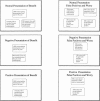A randomized trial of three videos that differ in the framing of information about mammography in women 40 to 49 years old
- PMID: 14687272
- PMCID: PMC1494949
- DOI: 10.1046/j.1525-1497.2003.21152.x
A randomized trial of three videos that differ in the framing of information about mammography in women 40 to 49 years old
Abstract
Objective: To assess the effect of providing structured information about the benefits and harms of mammography in differing frames on women's perceptions of screening.
Design: Randomized control trial.
Setting: General internal medicine academic practice.
Participants: One hundred seventy-nine women aged 35 through 49.
Intervention: Women received 1 of 3 5-minute videos about the benefits and harms of screening mammography in women aged 40 to 49. These videos differed only in the way the probabilities of potential outcomes were framed (positive, neutral, or negative).
Measurements and main results: We measured the change in accurate responses to questions about potential benefits and harms of mammography, and the change in the proportion of participants who perceived that the benefits of mammography were more important than the harms. Before seeing the videos, women's knowledge about the benefits and harms of mammography was inaccurate (82% responded incorrectly to all 3 knowledge questions). After seeing the videos, the proportion that answered correctly increased by 52%, 43%, and 30% for the 3 knowledge questions, respectively, but there were no differences between video frames. At baseline, most women thought the benefits of mammography outweighed the harms (79% positive frame, 80% neutral frame, and 85% negative frame). After the videos, these proportions were similar among the 3 groups (84%, 81%, 83%, P =.93).
Conclusions: Women improved the accuracy of their responses to questions about the benefits and harms of mammography after seeing the videos, but this change was not affected by the framing of information. Women strongly perceived that the benefits of mammography outweighed the harms, and providing accurate information had no effect on these perceptions, regardless of how it was framed.
Figures
References
-
- Wells J, Marshall P, Crawley B, Dickersin K. Newspaper reporting of screening mammography. Ann Intern Med. 2001;135:1029–37. - PubMed
-
- Humphrey LL, Helfand M, Chan BK, Woolf SH. Breast cancer screening: a summary of the evidence for the U.S. Preventive Services Task Force. Ann Intern Med. 2002;137:347–60. - PubMed
-
- Ransohoff DF, Harris RP. Lessons from the mammography screening controversy: can we improve the debate? Ann Intern Med. 1997;127:1029–34. - PubMed
-
- Pauker SG, Kassirer JP. Contentious screening decisions: does the choice matter? N Engl J Med. 1997;336:1243–4. - PubMed
Publication types
MeSH terms
Grants and funding
LinkOut - more resources
Full Text Sources
Medical


